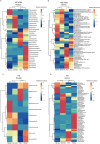Gut bacterial and fungal communities of François' langur (Trachypithecus francoisi) changed coordinate to different seasons
- PMID: 40109980
- PMCID: PMC11920163
- DOI: 10.3389/fmicb.2025.1547955
Gut bacterial and fungal communities of François' langur (Trachypithecus francoisi) changed coordinate to different seasons
Abstract
Introduction: François' langur (Trachypithecus francoisi), an endangered primate endemic to limestone forests in Vietnam and China, relies on gut microbiota to maintain gastrointestinal stability and adapt to dietary shifts. While gut microbial communities are dynamic and sensitive to seasonal and resource variations, their specific responses in François' langurs remain poorly characterized. This study investigates seasonal variations in the composition and diversity of gut bacterial and fungal communities in this species to enhance understanding of its ecological adaptations.
Methods: Fresh fecal samples from 22 François' langurs in Mayanghe National Nature Reserve, China, were collected across four seasons. Bacterial and fungal communities were analyzed using high-throughput sequencing to assess taxonomic composition and α-diversity. Statistical comparisons were conducted to evaluate seasonal differences at phylum and genus levels.
Results: Significant seasonal shifts occurred in both bacterial and fungal communities. Bacterial α-diversity peaked in warmer seasons, whereas fungal diversity was higher in colder months. At the genus level, Akkermansia (1.3% relative abundance in summer), a mucin-degrading bacterium linked to gut health, dominated warmer seasons. In contrast, the fungal genus Cercophora, associated with plant biomass degradation, was enriched during colder seasons. Seasonal factors strongly influenced microbial structure, with distinct community assemblages observed across all seasons.
Discussion: The inverse diversity patterns of bacterial and fungal communities suggest complementary roles in nutrient extraction under seasonal dietary constraints. Akkermansia's summer prevalence may reflect enhanced mucin utilization during fruit-rich periods, while Cercophora's cold-season dominance likely aids cellulose breakdown in leaf-heavy diets. These dynamics highlight the microbiota's role in optimizing energy harvest from seasonally variable diets. By elucidating microbial seasonal plasticity, this study provides critical insights for developing conservation strategies tailored to the nutritional ecology of François' langurs.
Keywords: Akkermansia; Cercophora; François’ langur; bacterial diversity; fungal diversity; gut microbiota; seasonal variation.
Copyright © 2025 Liu, Zou, Li, Wang and Han.
Conflict of interest statement
The authors declare that the research was conducted in the absence of any commercial or financial relationships that could be construed as a potential conflict of interest.
Figures






Similar articles
-
Evaluation of Gut Microbiota Stability and Flexibility as a Response to Seasonal Variation in the Wild François' Langurs (Trachypithecus francoisi) in Limestone Forest.Microbiol Spectr. 2023 Aug 17;11(4):e0509122. doi: 10.1128/spectrum.05091-22. Epub 2023 Jul 5. Microbiol Spectr. 2023. PMID: 37404157 Free PMC article.
-
The composition and function of the gut microbiota of Francois' langurs (Trachypithecus francoisi) depend on the environment and diet.Front Microbiol. 2023 Nov 16;14:1269492. doi: 10.3389/fmicb.2023.1269492. eCollection 2023. Front Microbiol. 2023. PMID: 38033571 Free PMC article.
-
The range and habitat suitability of François' langur (Trachypithecus francoisi) in Mayanghe Nature Reserve, China.Environ Sci Pollut Res Int. 2023 Mar;30(14):40952-40960. doi: 10.1007/s11356-023-25170-x. Epub 2023 Jan 10. Environ Sci Pollut Res Int. 2023. PMID: 36626052
-
Positional Behaviours of François' Langur (Trachypithecus francoisi) in the Limestone Forest of Nonggang, Guangxi, South-West China.Folia Primatol (Basel). 2020;91(3):170-187. doi: 10.1159/000502503. Epub 2019 Oct 23. Folia Primatol (Basel). 2020. PMID: 31645031
-
Captivity restructures the gut microbiota of François' langurs (Trachypithecus francoisi).Front Microbiol. 2023 May 12;14:1166688. doi: 10.3389/fmicb.2023.1166688. eCollection 2023. Front Microbiol. 2023. PMID: 37250037 Free PMC article.
References
-
- Atta M., Ruiz-Larrea F. (2022). Fungal Pectinases in Food Technology. London: InTechOpen. 10.5772/intechopen.100910 - DOI
LinkOut - more resources
Full Text Sources

